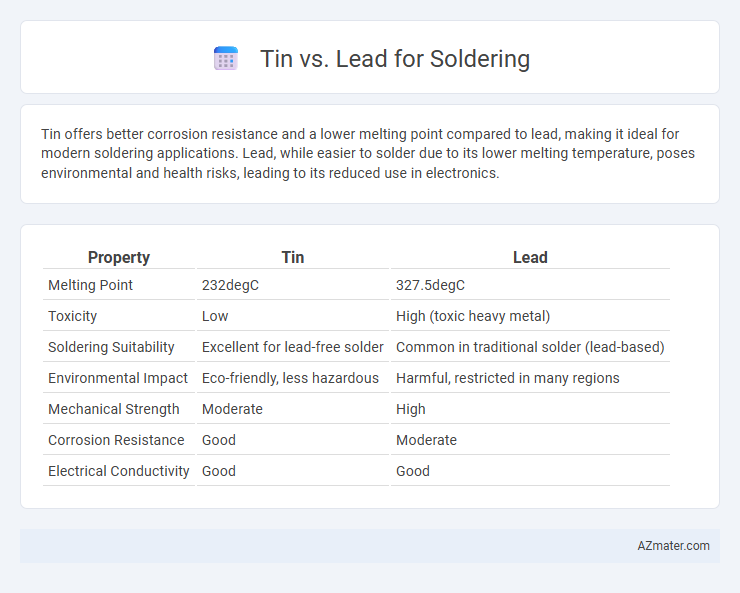Tin offers better corrosion resistance and a lower melting point compared to lead, making it ideal for modern soldering applications. Lead, while easier to solder due to its lower melting temperature, poses environmental and health risks, leading to its reduced use in electronics.
Table of Comparison
| Property | Tin | Lead |
|---|---|---|
| Melting Point | 232degC | 327.5degC |
| Toxicity | Low | High (toxic heavy metal) |
| Soldering Suitability | Excellent for lead-free solder | Common in traditional solder (lead-based) |
| Environmental Impact | Eco-friendly, less hazardous | Harmful, restricted in many regions |
| Mechanical Strength | Moderate | High |
| Corrosion Resistance | Good | Moderate |
| Electrical Conductivity | Good | Good |
Introduction to Soldering Metals
Tin and lead are the primary metals used in soldering alloys, with tin providing superior corrosion resistance and electrical conductivity while lead improves joint malleability and lowers melting points. Traditional solder typically comprises a 60/40 ratio of tin to lead, balancing ease of use and strong mechanical bonds. Modern soldering increasingly favors lead-free alternatives, often alloyed with silver or copper, driven by environmental regulations and health concerns.
Tin and Lead: Basic Properties
Tin, a silvery metal with a low melting point of 232degC, offers excellent corrosion resistance and is non-toxic, making it ideal for soldering applications. Lead, characterized by its low melting point of 327degC and malleability, enhances solder's mechanical strength but poses health hazards due to its toxicity. Combining tin and lead in solder alloys optimizes melting temperatures and improves joint durability while balancing safety concerns.
Historical Use of Tin and Lead in Solder
Tin and lead have been historically the primary metals used in soldering due to their low melting points and excellent wetting properties. The traditional tin-lead solder, typically composed of 60% tin and 40% lead, dominated electronics manufacturing throughout the 20th century because of its reliable mechanical and electrical connections. Regulatory changes like RoHS have since led to the decline of lead usage, promoting tin-based alloys to address environmental and health concerns.
Melting Points and Workability
Tin melts at approximately 232degC, offering a lower melting point that facilitates easier soldering compared to lead, which melts at around 327degC. Tin's lower melting temperature reduces thermal stress on components, enhancing workability in precision electronics assembly. Lead's higher melting point provides stronger mechanical joints but poses challenges for heat-sensitive components and is less environmentally friendly than lead-free tin-based solders.
Electrical Conductivity Comparison
Tin offers significantly higher electrical conductivity compared to lead, making it a preferred choice for soldering in modern electronics where efficient signal transmission is critical. Lead's lower conductivity results in increased resistance and potential signal loss, which can impact performance in sensitive electrical circuits. The move towards tin-based solder alloys enhances overall circuit reliability and reduces energy loss in electronic components.
Health and Safety Considerations
Tin-based solder alloys, often combined with silver or copper, offer a safer alternative to lead-based solder by significantly reducing exposure to toxic lead fumes and lead dust. Lead solder poses serious health risks including lead poisoning, neurological damage, and reproductive harm, necessitating strict ventilation and protective measures during use. Regulatory agencies such as OSHA and RoHS restrict lead content in electronics manufacturing, promoting tin-based solders to enhance workplace safety and environmental health.
Environmental Impact: Tin vs Lead
Tin solder is significantly more environmentally friendly than lead solder due to its non-toxic properties and compliance with regulations like RoHS, which restrict harmful substances in electronics. Lead solder poses serious environmental hazards because lead is a toxic heavy metal that contaminates soil and water, leading to health risks in humans and wildlife. The shift to lead-free tin-based solder reduces hazardous waste and promotes safer recycling and disposal practices in electronic manufacturing.
Solder Joint Strength and Reliability
Tin-based solder alloys, such as SAC305 (96.5% tin, 3% silver, 0.5% copper), offer superior solder joint strength and enhanced reliability compared to traditional lead-based solders due to their higher tensile strength and better thermal fatigue resistance. Lead solder, typically composed of 60% tin and 40% lead, provides good wetting and ductility but is more prone to joint degradation under cyclic thermal stress and mechanical vibration. The transition to lead-free solder enhances long-term reliability in electronics by reducing susceptibility to tin whisker growth and lead-induced environmental toxicity.
Modern Alternatives and Lead-Free Solder
Modern soldering increasingly favors tin-based alloys, such as tin-silver-copper (SAC) compositions, due to their superior environmental and health profiles compared to traditional lead-tin solders. Lead-free solder solutions reduce toxic exposure and comply with regulations like RoHS, promoting safer electronics manufacturing. Despite slightly higher melting points and cost, tin-based alternatives offer reliable mechanical strength and electrical conductivity for contemporary electronic assemblies.
Choosing the Right Metal for Your Application
Choosing between tin and lead for soldering depends on factors such as melting point, conductivity, and safety. Tin solder offers a lower melting point (around 232degC) and is lead-free, making it ideal for electronics where health and environmental standards apply. Lead solder, with a melting point near 183degC, provides excellent flow and joint strength but raises health concerns, making it less suitable for consumer electronics or food-related applications.

Infographic: Tin vs Lead for Soldering
 azmater.com
azmater.com